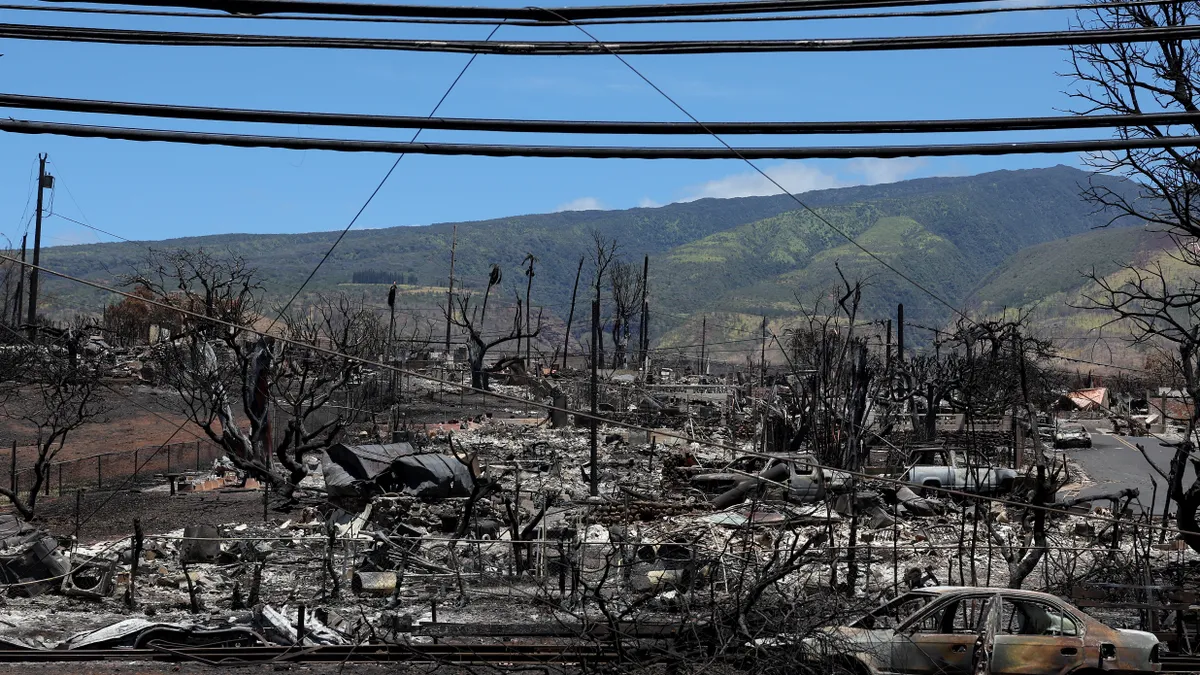Dive Brief:
- Hawaiian Electric is seeking advice about possibly restructuring in bankruptcy in the wake of devastating wildfires on Maui as part of “prudent scenario planning,” the utility and its parent company Hawaiian Electric Industries said on Friday in a U.S. Securities and Exchange Commission filing.
- Whether Maui Electric, a Hawaiian Electric subsidiary that serves Maui, is financially ring-fenced from its parent is “a complex legal question that will take time to work through,” the utility and HEI, a holding company, said.
- There are major questions about the cause of the wildfires and Hawaiian Electric’s role in them, according to Paul Patterson, an equity analyst with Glenrock Associates. “We don't know what took place yet,” he said Monday. “There’s obviously understandable concern — with high winds and the power not being deenergized — that they're responsible for these fires, although it's not really known.”
Dive Insight:
On Aug. 8, strong winds from Hurricane Dora drove the rapid spread of wildfires through the town of Lahaina and other areas in Maui, Hawaiian Electric and HEI said in its investor update filing with the SEC.
There were 114 fatalities in the fires as of Sunday, according to the Maui Police Department. About 850 people are missing, Maui Mayor Richard Bissen said Sunday. The fires caused an estimated $6 billion in damage on Maui, according to Hawai’i Gov. Josh Green, D.
The Hawai’i attorney general on Aug. 11 ordered a review of wildfire-related decision-making and policies.
Hawaiian Electric faces at least three lawsuits related to the wildfires, including two seeking class action status. One was filed by “premier fire litigation” firm Singleton Schreiber, another one by two Hawaiian law firms, and a third by two firms from California and one from Hawai’i.
Among other things, the lawsuits contend Hawaiian Electric should have de-energized its power lines to prevent them from starting fires.
“Facts about this event will continue to evolve,” Shelee Kimura, Hawaiian Electric president and CEO, said in an update. “While we may not have answers for some time, we are committed, working with many others, to find out what happened.”
Hawaiian Electric and HEI are exploring the possibility of bankruptcy.
“Like any company in this situation would do, and as we do in the normal course of business, we are seeking advice from various experts,” they said in the SEC filing. “This is part of prudent scenario planning.”
They said their goal is not to restructure the company, but to endure as a financially strong utility.
“Hawaiian Electric’s primary focus right now is on supporting emergency response efforts, helping our customers and employees and continuing to restore power as quickly as possible,” they said.
Hawaiian Electric wouldn’t be the first utility to enter bankruptcy because of wildfire-related liabilities. Pacific Gas & Electric filed for bankruptcy in January 2019 in the face of about $30 billion in liabilities from wildfires including the Camp Fire — which caused at least 85 deaths, burned more than 153,000 acres and destroyed 18,000 buildings. The San Francisco-based utility emerged from bankruptcy in July 2020 and continues to focus on reducing wildfire risks.
Unlike in California, there is no precedent in Hawai’i applying inverse condemnation to a private party like an investor-owned utility, Hawaiian Electric and HEI said. Under inverse condemnation, a utility is strictly liable for a wildfire caused by their equipment, even if it behaved prudently.
As of Thursday, about 1,900 customers in West Maui remained without electricity, not counting the roughly 2,600 homes and businesses that were destroyed, according to HEI and Hawaiian Electric. Power has been restored to more than 80% of customers who have been without electricity since last week, they said.
The utility is replacing some of the roughly 400 poles, 300 transformers and other equipment damaged by the fires and high winds and conducting extensive repairs, according to Kimura.
Hawaiian Electric is also suspending bills for about 18,000 customers in the affected areas so “those who have experienced a loss can focus on their well-being and taking care of themselves and their families,” Kimura said.
Hawaiian Electric and its utility subsidiaries – Hawaii Electric Light and Maui Electric – serve about 95% of people in Hawai’i.
The utilities don’t have a power shutoff program to preemptively cut power ahead of high-risk weather, HEI and Hawaiian Electric said.
Short-notice power shutoffs have to be coordinated with first responders, and in Lahaina, electricity powers some of the water pumps used for firefighting, according to the companies. “A power shut-off can jeopardize the health and safety of the elderly, the disabled and those most in need,” they said.
On the financial front, HEI had net income last year of $241 million, including $189 million in utility income, on $3.74 billion in revenue.
Like other utilities, Hawaiian Electric doesn’t have insurance to cover damage to its transmission and distribution system, the company said in its most recent annual report. It also lacks “business interruption” insurance.
“If a hurricane or other uninsured catastrophic natural disaster were to occur, and if the [Hawaii Public Utilities Commission] did not allow the affected utilities to recover from ratepayers restoration costs and revenues lost from business interruption, the lost revenues and repair expenses could result in a significant decrease in HEI’s consolidated net income,” the company said.
Editor’s note: This story has been updated to include the number of missing people and the estimated cost of the wildfires on Maui.















